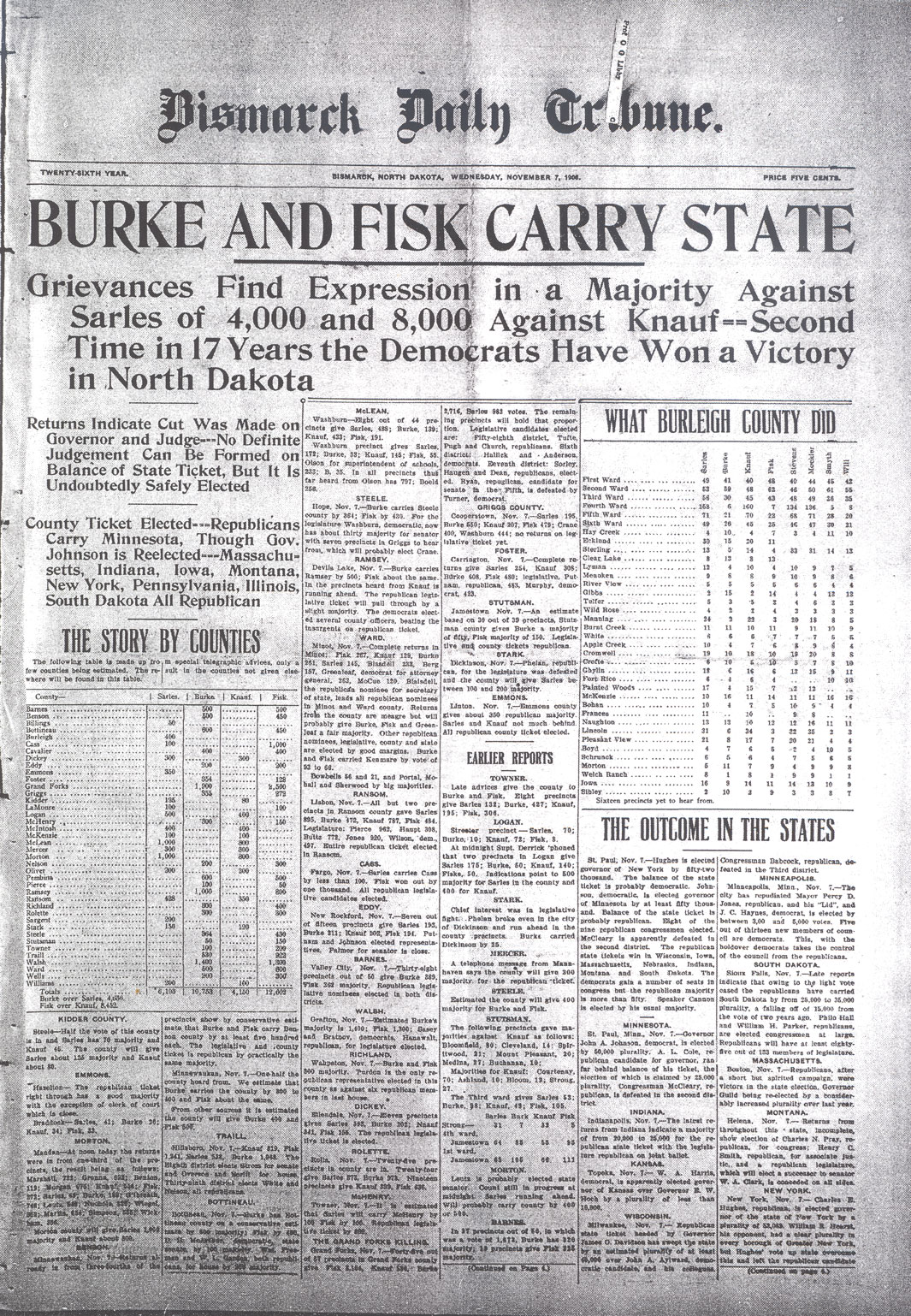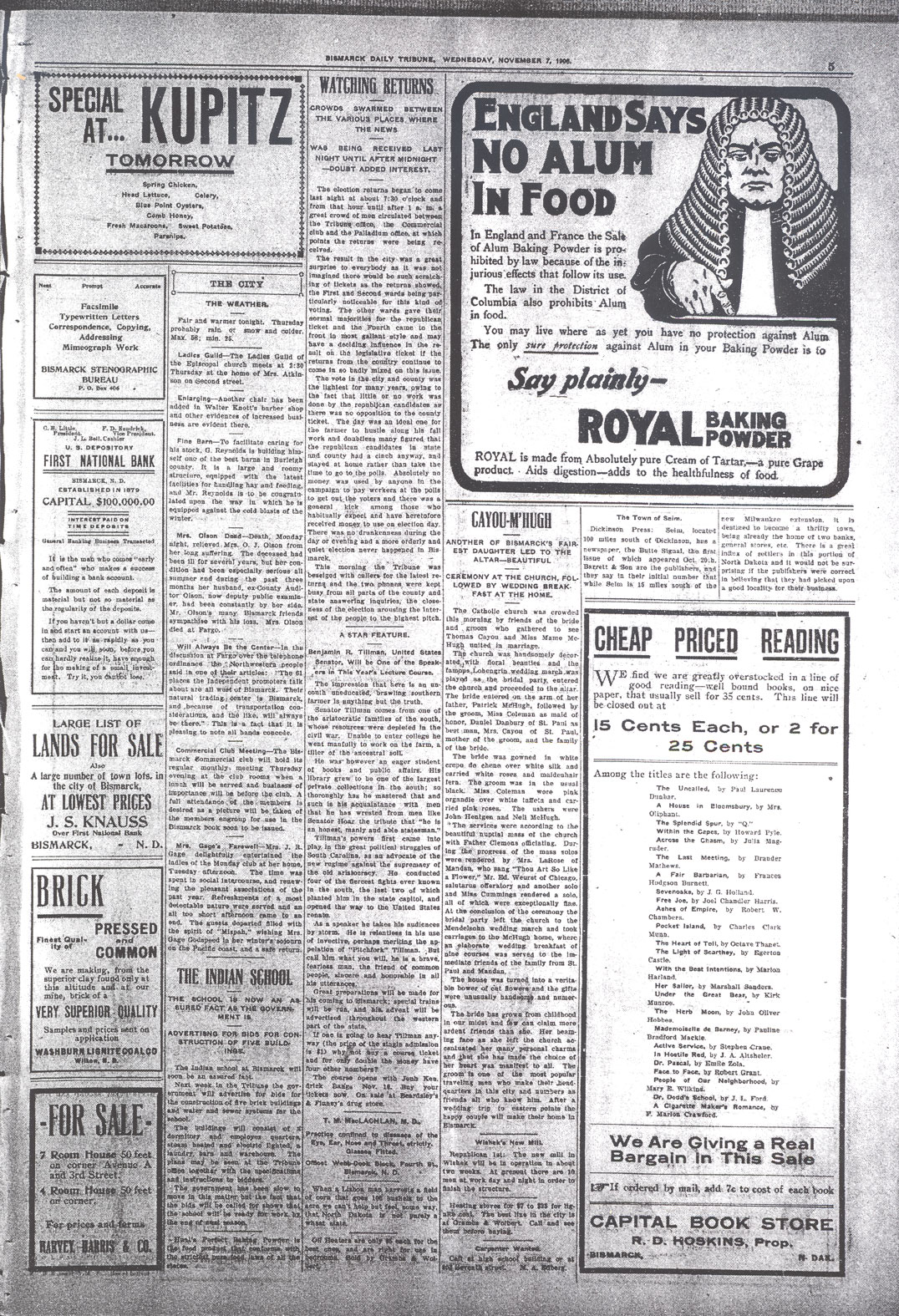As the election of 1906 approached, Alexander McKenzie was confident that his candidates would win in the polls. McKenzie supported Governor Elmore Y. Sarles (Republican) for re-election. Sarles had served a two-year term as governor, but Progressive Republicans and Prohibitionists were concerned that Sarles openly disobeyed the prohibition laws when he drank beer in public.
McKenzie also supported John Knauf for Justice of the North Dakota Supreme Court. Knauf was, at that time, serving an appointment on the Supreme Court, but he had to stand for election in 1906. Knauf was unacceptable to many North Dakotans because he had swindled a client out of money. The state bar association refused to support his nomination. Sarles and Knauf presented problems that weakened the Republican ticket.
The Progressive Republicans had been growing stronger and had occasionally allied with Democrats in the legislature. In 1905, the Progressive Republicans had organized the Good Government League which tried to control the Republican Party and reform North Dakota politics.
Several other factors worked against McKenzie’s control. Norwegian voters, a significant voting bloc, turned to the Progressive wing of the Republican Party. McKenzie’s insults toward Swedes and his efforts to buy votes bothered Norwegian voters, too. The Farmers’ Alliance had dissolved, but their political interests still echoed among farmers. The new farmers’ organization, The American Society of Equity,The American Society of Equity was a national farmers’ organization that focused on economic issues. It began in 1902 and remained in existence until 1934. It was particularly strong in Wisconsin, but was also important in North Dakota. Though the Society never had the political strength of the Farmers’ Alliance, it was successful in forming purchasing cooperatives in many areas. In North Dakota, many members of the Society formed the Nonpartisan League. continued to remind farmers that McKenzie’s machine did not favor their interests.
John Burke, the Democratic candidate, won the election by a large margin. Burke polled 34,424 votes (53%) to Sarles’ 29,309 votes (45%). The Socialist candidate, Dow, won only 978 votes.By comparison, the Democratic candidate for governor in 1904 lost by a 3 to 1 margin. Sarles, in 1904 won 48,026 votes. The Democratic candidate Hegge gathered only 16,744 votes. The Socialist candidate, Mr. Basset, received only 1,760 votes in 1904. Another candidate named Aaker polled 1,388 votes. The huge turn-around for the Democratic candidate in 1906 reveals that the voters had great confidence in John Burke and had begun to tire of McKenzie’s political machine. (See Document 5)
Historians have questioned whether Burke’s election was a true revolution. There was no great turn-about in politics. Burke did not favor farmers’ issues, though he did help to bring about some reforms that gave North Dakota citizens more voice in governmental affairs. However, it is good to remember that the phrase, “The Revolution of 1906,” echoes what the people called this turn in political events in 1906. Many North Dakotans were happy to break the cycle of electoral politics that Alexander McKenzie had controlled since 1883. Voters had also elected enough Progressive Republicans to support reform.
Alexander McKenzie did not disappear from North Dakota politics. He continued to wield influence into the early 1920s. However, after 1906, McKenzie had to share political power with Progressive Republicans, Democrats, and, later, the Nonpartisan League.
Why is this important? The power of government lies with the people. Before John Burke became governor, the people of North Dakota had little political power. The voters’ interests were sometimes overruled by Alexander McKenzie who worked for the railroads and the grain mills. As long as the railroads and the milling companies deprived North Dakota farmers of political power, the big corporations could continue to control the governorship and the legislature. Once the voters were able to install an honest and progressive government, they were able to expand the peoples’ political rights. The new political balance among the political parties and the voters was a healthier political system for North Dakota and more compatible with a constitutional democracy.
To find data on state government elections: https://vip.sos.nd.gov/ElectionResultsPortal.aspx
John Burke: “North Dakota’s Lincoln”
On the grounds of the North Dakota state capitol, there is a statue of “Honest” John Burke, who was also called “North Dakota’s Abraham Lincoln.” Like Lincoln, he was tall and thin. He had a large nose and large ears. (See Image 2) He liked to tell funny stories.Burke liked to tell the story of the time he was defending a man accused of a crime. The judge in the case, looking at Burke’s simple and homely appearance, assumed that Burke was the accused criminal, rather than the defense attorney. North Dakotans admired Burke because he was honest and deeply committed to the rule of law.

Burke was the son of poor Irish immigrants. He went to work at an early age and had little formal education. He was, except for his two years at the University of Iowa law school, self-educated. He came to North Dakota in 1888 and set up a law office in St. John where he also taught school and ran a newspaper.
Burke joined the Democratic Party and became involved in state politics. He was elected to the North Dakota House in 1890 and later served two terms in the North Dakota Senate. During his time in the legislature, he gained a reputation for being honest. He was a lawmaker who believed in enforcing the laws. Though most Democrats favored the repeal of the prohibition laws, Burke realized that the laws were the result of legitimate political processes and were “here to stay.” He believed that prohibition laws should be effectively enforced.
Burke’s politics, at first, did not particularly favor farmer’s interests. During the years when Alexander McKenzie ruled North Dakota politics, Burke often voted with the Stalwart Republicans in opposition to bills that would regulate the railroads and establish terminal grain elevators.Grain elevators are tall, tower-like buildings, usually located next to railroad tracks, where grain is scooped up for storage in a tall silo. A local or country elevator is where farmers took their grain for storage until the railroad picked up the grain and transported it to a terminal elevator in Minnesota cities of Minneapolis, St. Paul, or Duluth. At a terminal elevator, the grain was either milled (turned into flour) in Minnesota, or it was prepared for export to another country. None of North Dakota’s grain elevators were terminal elevators.
Farmers received a low price for their grain in North Dakota because the grain would be shipped a great distance before milling. Farmers also had to pay storage fees to the elevators. Many farmers believed that a terminal elevator in or owned by the state of North Dakota would give farmers a better price for their grain.
Many grain dealers cheated farmers by giving the wheat a lower grade than it deserved. Many farmers delivered No. 1 Hard Red Spring Wheat to the local elevator. Some greedy grain dealers, however, graded the wheat as Number 2 or Number 3 Hard. The lower grades brought in a lower price per bushel. Farmers wanted the state to establish a grain grading system to ensure that they received the best price for their crops. However, as the misdeeds of Alexander McKenzie’s political “machine” became more widely known, Burke began to focus on political corruption.
Burke was nominated for governor in 1906. As a Democrat, there was little chance for Burke to win office. However, the Democrats were hopeful that McKenzie’s corruption would help them win the governorship. Many Progressive Republicans also supported Burke.
In 1906, Burke campaigned against the power of the railroads over North Dakota politics. He focused his campaign on the corruption of the political process that had characterized North Dakota government for decades. Burke won the election. The people of North Dakota called his election “The Revolution of 1906.” Burke had broken, but not destroyed, McKenzie’s control of over North Dakota. Burke’s directness, his simplicity, and his honesty were qualities that voters liked. He was elected again in 1908 and 1910.


John Burke was not a farmers’ governor, though he pleased most farmers with his honesty. He did not establish a terminal elevator or state grain-grading system. He was very popular among city dwellers who were tired of McKenzie’s corrupt policies. As governor, Burke presided over the modernizing of state government. (See Image 3) New government agencies and bureaus took care of the daily business of the government. Burke’s third administration (begun in 1910) saw the passage of several pieces of legislation that were considered to be progressive. These reforms included primary elections, direct election of Senators, initiative, referendum, and recall. The legislature also passed bills regarding child labor, a juvenile court system, public health, and safety regulations for railroads. (See Image 4)

When Burke left office in 1913, he was not finished with government service. (See Image 5) He supported Woodrow Wilson in his campaign for the presidency. Wilson appointed Burke United States Treasurer. After leaving this federal office in 1921, he again practiced law. In 1924, North Dakota voters elected him to the North Dakota Supreme Court. He was elected two more times.
John Burke died in 1937. He had earned a reputation as one of the most respected politicians in North Dakota’s history.
Why is this important? John Burke reversed the political patterns of North Dakota’s early statehood politics. He proved that an honest politician could earn votes and use political power legitimately for the good of the people and the state.

In 1959, the North Dakota National Statuary Hall Commission chose Governor John Burke to represent North Dakota in the National Statuary Hall in the U. S. Capitol in Washington, D. C. Dr. Avard Fairbanks sculpted the statue which was installed at our nation’s capitol on June 27, 1963. The statue on the capitol grounds in Bismarck is a duplicate of the statue in National Statuary Hall. (See Image 6)






